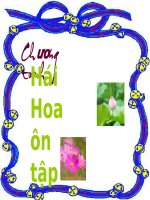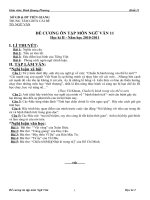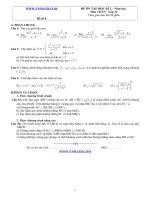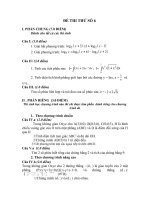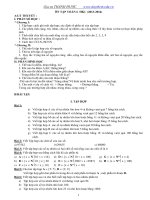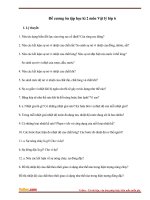Ôn tập học kì 2 khối 6 - Đề 2
Bạn đang xem bản rút gọn của tài liệu. Xem và tải ngay bản đầy đủ của tài liệu tại đây (381.41 KB, 5 trang )
<span class='text_page_counter'>(1)</span><div class='page_container' data-page=1>
PHÒNG GD&ĐT QUẬN LONG BIÊN
<b>TRƯỜNG THCS THANH AM </b>
<b>Năm học 2020 - 2021 </b>
<b>Đề số 2 </b>
<b>ĐỀ ƠN TẬP HỌC KÌ II </b>
<b>MƠN: TỐN HỌC 6 </b>
<b>Thời gian: 90 phút </b>
<b>Câu 1 (2đ). Thực hiện phép tính (tính nhanh nếu có thể): </b>
a)
1 1 415− +3 5
b)
5 6 7
13 11 13 11 13
5 5
. . +
− <sub>+</sub> −
c)
93 21 635 3 5
−<sub></sub> + <sub></sub>
d)
1 7 10
2 .2, 5 75% :
5 4 7
−<sub></sub> + <sub></sub>
<b>Câu 2 (2đ). Tìm x, biết: </b>
a)
3 54 <i>x</i> 2
−
+ =
b)
2 2: x 17−7 = 2
c)
(
)
2 3 7
x 3
8 16
+ + =
<b>Câu 3 (2đ). </b>
Bà Tư thu hoạch được 120 kg cà chua. Ngày thứ
nhất bà bán được 20% số cà chua này. Ngày thứ 2
bà bán được
16
số cà chua đã thu hoạch. Ngày thứ
3 bà phải bỏ đi 2kg quả cà chua bị hỏng và sau đó
bán nốt số cà chua cịn lại.
a) Tính số kg cà chua đã bán trong mỗi ngày của
bà Tư?
b) Tính tỉ số phần trăm số kg cà chua đã bán trong
ngày thứ 2 và ngày thứ 1 của bà Tư ?
<b>Câu 4 (3,5đ). Trên cùng một nửa mặt phẳng bờ chứa tia O</b>
<i>x</i>
, vẽ tia Oy và tia Oz sao
cho
040
<i>xOy</i>=
,
0100
<i>xOz</i>=
.
a) Tính số đo của
<i>yOz</i>?
b) Tia Oy có là tia phân giác của
<i>xOz</i><sub> khơng? Vì sao? </sub>
c) Vẽ tia Om là tia phân giác của
<i>xOy</i>, tia Ot là tia đối của tia Om.
Tính số đo của
<i>yOt</i>?
<b>Câu 5 (0,5đ). Tính tổng </b>
1 1 1 1 ... 11.6 6.11 11.16 16.21 496.501
<i>A</i>= + + + + +
</div>
<span class='text_page_counter'>(2)</span><div class='page_container' data-page=2>
<b>---TRƯỜNG THCS THANH AM </b>
<b>NĂM HỌC 2020-2021 </b>
<b>ĐỀ ƠN TẬP CUỐI HỌC KÌ II </b>
<b>MÔN: NGỮ VĂN </b>
<b>ĐỀ SỐ 2 </b>
<b>I. ĐỌC HIỂU (5,0 điểm) </b>
<b>Đọc đoạn thơ sau và trả lời các câu hỏi: </b>
<i>“Chú bé loắt choắt </i>
<i>Cái xắc xinh xinh </i>
<i>Cái chân thoăn thoắt </i>
<i>Cái đầu nghênh ngênh </i>
<i>Ca lô đội lệch </i>
<i>Mồm huýt sáo vang </i>
<i>Như con chim chích </i>
<i>Nhảy trên đường vàng” </i>
(Trích Ngữ Văn 6, tập 2, NXBGD - 2006)
<b>Câu 1:</b>
Đoạn thơ trên được trích trong văn bản nào? Tác giả là ai? Trình bày ngắn gọn
hoàn cảnh sáng tác của văn bản chứa đoạn thơ.
<b>Câu 2:</b>
Giải nghĩa từ loắt choắt? Xét về cấu tạo, từ ”loắt choắt” thuộc kiểu từ nào?
<b>Câu 3:</b>
Câu văn sau mắc lỗi sai nào về chủ ngữ, vị ngữ? Hãy sửa lại cho đúng.
<i><b>“Qua đoạn thơ đã cho người đọc cảm nhận được vẻ đáng yêu, vô tư, hồn nhiên của </b></i>
<i><b>Lượm.” </b></i>
<b>Câu 4:</b>
Chỉ rõ và nêu tác dụng của biện pháp tu từ so sánh được sử dụng trong đoạn thơ.
<b>Câu 5:</b>
Nêu tên văn bản, tác giả của 01 văn bản trong chương trình Ngữ Văn 6, tập 2 có cùng
hoàn cảnh sáng tác với bài thơ trên.
<b>II. TẬP LÀM VĂN (5,0 điểm)</b>
</div>
<span class='text_page_counter'>(3)</span><div class='page_container' data-page=3>
<i><b>Trường THCS Thanh Am </b></i>
<b>BÀI TẬP ÔN TẬP MÔN TIẾNG ANH 6 </b>
<b>Tuần từ 31/5/2021 – 5/6/2021 </b>
<b>I. Find the word which has a different sound in the underlined part. </b>
1.<b> A.</b> card <b>B.</b> hand <b>C.</b> band <b>D.</b> stand
2.<b> A.</b> thank <b>B.</b> think <b>C.</b> through <b>D.</b> then
3.<b> A.</b> town <b>B.</b> own <b>C.</b> cow <b>D.</b> town
4.<b> A.</b> loud <b>B.</b> should <b>C.</b> sound <b>D.</b> mountain
5.<b> A.</b> yard <b>B.</b> bad <b>C.</b> cat <b>D.</b> hat
<b>II. Choose the correct answers. </b>
6. If people can wastes, they will save a lot of money.
<b>A.</b> reuse <b>B.</b> reduce <b>C.</b> rebuild <b>D.</b> use
7. new technology, we now have super smart TVs, smart phones.
<b>A.</b> Because <b>B.</b> Because of <b>C.</b> Thanks <b>D.</b> Thanks to
8. Robots will do most of the housework, we will have more time for our family.
<b>A.</b> so <b>B.</b> but <b>C.</b> although <b>D.</b> if
9. We should have recycling bins in each classroom for things.
<b>A.</b> use <b>B.</b> reuse <b>C.</b> reused <b>D.</b> reusable
10. If we plant more trees, the will be greener.
<b>A.</b> neighbour <b>B.</b> soil <b>C.</b> air <b>D.</b> neighbourhood
11. All of the machines will have a special card .
<b>A.</b> start <b>B.</b> to start <b>C.</b> starting <b>D.</b> to starting
12. If we all the trees, there will be no more oxygen for us to breathe.
<b>A.</b> cuts <b>B.</b> cut off <b>C.</b> cutting <b>D.</b> cut down
13. We should open all the windows, so we don't use air-conditioners.
<b>A.</b> have <b>B.</b> have to <b>C.</b> needn't <b>D.</b> need
14. Plant more trees in the schoolyard because they will provide shade and the atmosphere fresher.
<b>A.</b> do <b>B.</b> make <b>C.</b> have <b>D.</b> use
15. Our dream house will use only solar energy so that we can make the clean and green.
<b>A.</b> nature <b>B.</b> environment <b>C.</b> kitchen <b>D.</b> home
16. Many products are now helping you your energy bills.
<b>A.</b> reduce <b>B.</b> reuse <b>C.</b> recycle <b>D.</b> cut down
17. It takes a lot of energy to keep food cool, so don't the fridge door open or putting hot things inside.
<b>A.</b> make <b>B.</b> have <b>C.</b> leave <b>D.</b> stop
18. Future houses will have hi-tech rooms for all of the family members.
<b>A.</b> read <b>B.</b> to read <b>C.</b> reading <b>D.</b> to reading
19. Our houses will use the sun or the wind electricity.
<b>A.</b> to have <b>B.</b> to do <b>C.</b> to make <b>D.</b> to give
20. In the future, cars might use energy from .
<b>A.</b> gas <b>B.</b> water <b>C.</b> oil <b>D.</b> power
21. Our dream house will be located the sea.
<b>A.</b> on <b>B.</b> at <b>C.</b> in <b>D.</b> between
22. Don't old things because perhaps you will need them later.
</div>
<span class='text_page_counter'>(4)</span><div class='page_container' data-page=4>
23. causes many breathing problems.
<b>A.</b> Fresh air <b>B.</b> Fresher air <b>C.</b> Polluting air <b>D.</b> Polluted air
24. We won't use CD players because we will have smart watches that music.
<b>A.</b> play <b>B.</b> plays <b>C.</b> hear <b>D.</b> listen to
25. If you eat fast food, you will be fatter easily.
<b>A.</b> very <b>B.</b> very much <b>C.</b> too much <b>D.</b> most
<b>III. Complete the first conditional sentences. </b>
26. If we stay at home, we (miss) the show.
27. We (ask) about it, if you want.
28. If he (want) it, we'll buy it.
29. If it (not/ work) , we'll take it back.
30. They (not/ go) on holiday this year, if their friends come to see them.
31. You will be tired tomorrow if you (not/ go) to bed early.
32. (the boys/ wear) their new T-shirts tomorrow if it is sunny?
33. The cake (burn) if he doesn't turn off the oven.
34. We won't go to the beach tomorrow if it (rain) .
35. Will you walk to school if the bus (not/ come) soon?
<b>IV. Fill in each blank with ONE suitable word. </b>
36. Soil pollution can make die.
37. What do these three Rs for?
38. If we all use this kind of bag, we'll help to protect the .
39. We should find ways to reuse our old items before throwing them away.
40. If the river is not , there will be more fish.
<i><b>V. Complete the conversation with will, won't or might. </b></i>
<b>A</b> Do you think it (41) rain tomorrow?
<b> B </b> I don't think so. I think it (42) be sunny. It (43) be cloudy but it
certainly (44) be rainy.
<b> A</b> I think I (45) go to the beach.
<b>B</b> I (46) come with you or I (47) stay at home. I (48) help
my sister make a poster. She (49) need a new one.
<b>A</b> (50) you go to the library with me now?
<b>B </b> OK!
<b>VI. Complete the conversation. Use the first conditional. </b>
<b>A </b> (51) ?
(you come to the concert/ I buy the tickets)
<b>B</b> Yes, I (52) .
<b>A</b> I (53. ask) Jack if he (54. want) to come too.
<b>B</b> If Jack (55. come) , I (56) certainly go!
<b>A </b> OK. If I (57. see) her, I (58. ask) her.
<b>B</b> If she (59. not want) to come, I (60. ask) her out somewhere else.
<b>A</b> That's fine.
<b>VII. Read the passage, and then fill in each blank with ONE appropriate word.</b> produce
</div>
<span class='text_page_counter'>(5)</span><div class='page_container' data-page=5>
house will also have a hi-tech TV that helps us to watch TV programmes from space. A home robot will be able to
do all of (64) , so our life will become more comfortable than ever (65) .
61.<b> A.</b> much <b>B.</b> more <b>C.</b> most <b>D.</b> almost
62.<b> A.</b> sun <b>B.</b> solar <b>C.</b> sunny <b>D.</b> cloudy
63.<b> A.</b> appliances <b>B.</b> tools <b>C.</b> machines <b>D.</b> equip
64.<b> A.</b> housework <b>B.</b> the housework <b>C.</b> homework <b>D.</b> the homework
65.<b> A.</b> until <b>B.</b> after <b>C.</b> before <b>D.</b> then
<i><b>VIII. Read the text, and then decide whether the sentences are True or False. </b></i>
<i><b>As good as new </b></i>
Do you think that people can make a fun bag with old juice cartons? The colourful T-shirt was once plastic bottles.
It takes five large plastic bottles to make one large T-shirt. Scientists can make baseball caps from plastic bottles, too.
They can also make sports shoes from car tyres.
People use old newspapers, comics, and bus tickets to make beautiful bracelets.
Next time you are out shopping, see how many recycled items you can find. Or why not try making something new
from your old garbage? You can make greeting cards from old paper and magazines. You can make book covers from
old plastic bags, posters, maps or even clothes. You save wrapping paper, gift boxes, and ribbons and use them again.
66. The shoes might be car tyres. ___________
</div>
<!--links-->
